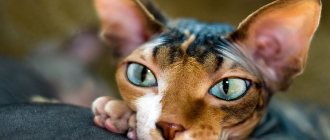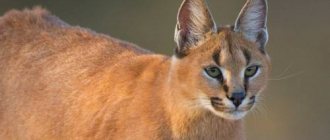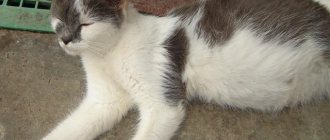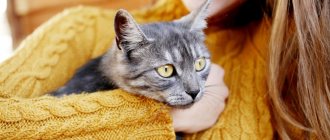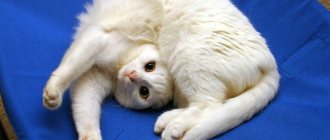Origin of the breed
These cats originally appeared on the islands of the Aegean Sea. The breed appeared independently in nature and is widespread mainly in Greece.
Wild representatives of the Aegean breed still live on the islands. There they feed on fish, which they themselves catch in the sea. The cat was brought to the mainland by sailors. So it spread throughout Greece.
Scientists paid attention to this breed in the 90s of the last century. At the same time, Greek breeders began breeding it. A purebred Aegean cat is very difficult to buy or even just see outside its native country. It is not common in Russia because of its color. You cannot buy such a cat in Russia, because no one breeds them.
Historical reference
In the Aegean Sea, there are many islands that carry the living history of ancient Greece and Byzantium. Tsikladis is one of the little-known islands that became the homeland of the modern Aegean cat. Unremarkable for the islanders, the “murki” lived next to people for hundreds of years. The main occupation of the local population, naturally, was fishing; the owners left their homes for a long time, and the cats were left to keep order. Predators destroyed pests that arrived on the island with sea cargo, in return, they received the loyal attitude of the islanders and a delicacy in the form of fish.
The Aegean cat breed has gone through all the stages of natural selection; at the time of its inception, pneumonia was a death sentence for people, to say nothing of veterinary medicine or breeding programs. Severe weather conditions during storms, temperature changes, viral infections and bacterial outbreaks, low tides, and then hunger “mowed down” the wild ancestors of Aegean cats, tempering the gene pool of the future breed.
Perhaps the everyday life of the islander cats would have gone unnoticed if not for a random coincidence. No, the breed was not noticed by a famous breeder or veterinary doctor; the Aegean cat was encountered by historians who explored the island. Further, the working notes of the research group ended up at the institute, where they were published in the form of a report, and a detailed description of the cats’ behavior attracted the attention of fans of four-legged animals. By the way, in the description of appearance, there were no special features; the ancestors of the “Aegeans,” like their modern counterparts, look more than usual.
This is interesting! Work to strengthen the standards of the Aegean breed began in the 1990s. However, the ordinary, even everyday appearance of cats keeps the breed in the “experimental” section.
Main features
Usually, purebred cats require exceptional care and guardianship from their owners, and these sissies rarely go outside, spending their lives in the house, lazily lying down and touching their owners. The Aegean cat will not be able to sit at home all the time. She needs space and fresh air. These cats require no more care than purebred cats.
Unlike most cats, Aegean cats are not only not afraid of water, but also love to bathe and swim. Washing her will be no more difficult than washing a child.
The favorite food of Aegean cats is fish. They faithfully wait on the shore for their fishermen owners with prey, and sometimes they can bring it themselves.
Purchasing a kitten
Many breeders consider breeding these animals unprofitable, so you can only buy an Aegean cat in its homeland in Greece or the Cyclades Islands.
The price of an Aegean cat varies from 10 to 20 five thousand rubles. The cost of a baby of this breed depends on appearance, gender and pedigree, and the final price is set only by the breeder.
Proud and independent, but at the same time affectionate and devoted, the Aegean cat will become a wonderful pet for any person and will bring only positive and bright emotions into the life of its owner.
Video
Photo with Aegean cat
1 of 30
Where to buy and what is the price?
As already mentioned, the Aegean cat is widespread only in Greece. In other countries, meeting an Aegean is very rare. The CIS is no exception. We do not have nurseries for these cats. They are bred only in their homeland.
You can purchase an animal abroad. The Aegean cat is expensive for its owner; its price starts from $300. The purer the pedigree, the more expensive the animal. Kittens brought from the Kikald Islands will fetch a very high price.
Before purchasing an animal from a breeder, you need to inquire about the pet’s roots and find out reviews about the seller. After all, there is a danger of running into a scammer and purchasing an ordinary yard cat for a lot of money.
The Aegean cat is a cute animal, the external description of which is similar to ordinary cats living in the yard. If you look at a photo of a Greek four-legged property and an ordinary yard “murka”, you may not find any differences. They lie not in external, but in internal traits, in a tempered character, excellent health, and good hunting qualities.
The cat is distinguished by a friendly character, sincere affection for the owner, devotion and kindness. Aegeans are also excellent hunters of rats and mice. If the question arises why you should give preference to this particular breed, the answer is obvious: the animal is smart, loyal and an excellent helper. Such a cat will suit residents of a private home and will save them from rodent infestations. Well, an additional bonus is that it’s interesting to have an animal at home that is a national treasure in its homeland.
Appearance
Aegean cats look very similar to ordinary yard cats.
The coat color combines several colors. The main color is white. Additional colors are black, cream, red, blue, gray and brown. There can be two or one additional colors. Most often, colored ears, paws, back, head and tail. There is usually two or three times more white in color than the others.
Eyes can be any shade from yellow to green. They are large, oval in shape and their outer corners are raised up. The head is triangular in shape, the muzzle is elongated, and the nose is straight.
These cats are medium-sized, strong and robust. The body has an elongated shape, the legs are long and large. The coat does not have a dense undercoat, but cats still do not freeze in the cold season. It has medium length and fluffiness.
Standards
Aegean cats are of medium size (height at the withers -25-28 cm) and light weight (4-5 kg). They are muscular and fit, with proportionally developed limbs.
| Standard | Description |
| Head | Medium in size, triangular in shape, with a wide forehead and small whisker pads. |
| Eyes | Almond-shaped, large, their inner corners are slightly beveled inward. Often outlined in black. The iris is colored in shades of green and yellow. |
| Nose | The bridge of the nose is wide, straight, the nose is short, the nose is all shades of pink. |
| Ears | Medium in size, quite wide at the base, narrowed at the tips. The shell is slightly pubescent on the inside, and abundantly pubescent on the outside. |
| Torso | The neck is powerful and strong, long. The body is harmoniously developed, sometimes, due to developed muscles, it seems massive. |
| Limbs | Long, lean, with rounded paw pads and long, tenacious claws. |
| Tail | Straight, long, with a narrow tip. |
| Wool | Medium length, fluffy, but moderately, in the area of the tail and collar. It feels silky and soft to the touch. There is no undercoat. |
The cost of an Aegean cat starts from 15,000 rubles: it would seem quite inexpensive. But the price tag depends on pedigree, appearance and even gender. A kitten from the Cycland Islands itself will cost much more. Add to this the cost of travel to Greece and back, and paperwork.
Character of Aegean cats
These cats are active and playful; they cannot sit in one place. They love to hunt, perfectly protect the house from rodents, but they pose a danger to small pets.
They are very smart, understanding, love communication and affection, but do not impose themselves. Children are treated patiently and do not scratch. Aegean cats love and try to protect small family members. They are not subject to training.
Aegean cats are as loyal to their owners as dogs, but they are not jealous and easily share affection with other pets and people.
If you talk to this cat, she will answer, in her cat language of course. They love it.
Cats will not tear up wallpaper and furniture, dirty everything around them and ignore the comments of their owners. They are not inclined to misbehave and disobey.
Cats love to be outside, running and playing in the fresh air. Sitting constantly in a house or apartment, they will feel bad and sad. For this cat, the best option would be a private home. If she lives in an apartment, then, if possible, the cat should be allowed to go outside at her own request or be walked daily for a long time, preferably without a leash.
Catering
Food from the human table, if it doesn’t destroy the cat’s digestive system, will “immobilize” it. So you will have to prepare the food separately. However, there are no particular difficulties, but it is important to know some nuances.
Natural products
First, remember: many of the foods we are familiar with cannot be given to cats. Here is the list:
- Stale, fatty or not properly processed meat, smoked meats, bones, fat;
- Flour, sweet, salty, sour, smoked, pickled, fried;
- Tomatoes, eggplants, potatoes, grapes, onions, garlic, grapes;
- Food for other animals;
- Tea, coffee, juices, compotes, mineral water, alcohol, whole cow's milk;
- Dried fruits, spices, salt, sugar, ketchup, mayonnaise;
- Products with dyes, flavor enhancers, GMOs.
Animals drink only water. Only purified water is poured (through a filter, distilled or settled), changed in the bowl 2 times a day and whenever it gets dirty. The temperature is comfortable for drinking (not hot or cold).
Expert opinion
Dusheba Vera Ivanovna
In 2010, she graduated from the Moscow State Academy of Veterinary Medicine named after K.I. Scriabin with honors, specializing in veterinary medicine. I regularly attend veterinary conferences, congresses, and webinars.
To get rid of hairballs inside, use a special paste (sold at a pet store) or sprouted grass.
What can a cat eat?
- Fresh or frozen meat (douse with boiling water before feeding): chicken, veal, beef, horse meat, turkey, rabbit, lamb. The meat is cut into pieces centimeter by centimeter, scalded with hot water, mixed with porridge (rice, millet, buckwheat, oatmeal, pearl barley), boiled chicken yolk or chopped quail egg is added, the dish is seasoned with vegetable oil (half a teaspoon of olive or vegetable) and offered cat.
- 2-3 times a week, meat is replaced with offal: boiled chicken liver, gizzards, hearts, cartilage, ground chicken necks.
- Aegean cats love fish, and, unlike all other cats, you can give it to them a lot and often. Navaga, saury, trout, flounder, salmon, cod - anything sold in the nearest store will do. But it is better to remove fins and large bones. Giving it raw is risky: parasites can enter the body through it, so it is better to stew the fish with vegetables: zucchini, carrots.
- Regarding vegetables: rarely do cats like raw vegetables. It is better to stew or boil them. Green peas, spinach, broccoli, asparagus, pumpkin, and fresh herbs from the garden are healthy.
Recommended food
Below are recommended super-premium foods. Links with the names of the food are clickable, on them you can, within our website, read the descriptions of the food and read reviews from owners of Aegean cats.
| Holistic | Holistic | Super premium |
| Innova Evo | Orijen | Blitz |
Caring for Aegean cats
Mandatory care for cats of this breed consists of several mandatory procedures:
- Vaccinations and vitamins;
- Combing fur during shedding;
- Bathing;
- Feeding;
- Treatment as needed.
Like ordinary cats, Aegean cats develop various parasites, and their ears and eyes become inflamed. They catch colds and get injured. Treatment of all these diseases is carried out by a veterinarian and does not require special rare medications. Prevention can be carried out with ordinary antiparasitic drugs, vitamins and good nutrition.
During shedding, the fur should be combed once a day with a wide comb or a special soft brush so that the fur does not gather in clumps and lie all over the house. At normal times, it is not necessary to brush your cat.
You need to bathe an Aegean cat just like a regular cat, if necessary or desired. It does not require mandatory washing. These cats like to bathe, so you can do this to please the animal.
A cat's diet must include fish. This is their common food in the wild and is essential for Aegean cats' health and development. In addition to fish, Aegean cats can eat special dry food and homemade food. It is undesirable to feed your cat very salty, spicy and sweet foods. An unbalanced diet can lead to brittle bones and lack of muscle elasticity, affecting the cat's appearance and activity.
Aegean cats do not have genetic diseases or predisposition to them.
The average lifespan of such a cat is 10 - 15 years.
The interesting story of ancient Greek cats
Modern man is accustomed to the fact that we are constantly surrounded by various cats, cats and kittens. They can be gently purring and angry, docile and aggressive, smart and intractable, in a word, different. Sometimes it seems as if cats have surrounded humans from time immemorial and that this has always been the case.
If you think about it, it will become clear that Homo sapiens once lived alone - without a cat, which at that time also existed perfectly well without him and, most likely, never thought about him. Moreover, this was not during the time of our distant ancestors of the Australopithecus, and not even at the time when stocky Neanderthals lived next to our Cro-Magnon ancestors, but, by evolutionary standards, quite recently - only a few thousand years ago.
Freya, leader of the Valkyries, in a chariot drawn by two cats.
It is known that cats were first domesticated in the Middle East, most likely in Ancient Egypt. However, even when the Egyptians were already making full use of cat services, in neighboring countries, for example in ancient Greece, things were difficult with cats for many centuries. This is evidenced by real historical facts that tell us how these furry animals lived on the territory of Ancient Hellas.
In ancient Greece, the cat was equated with the goddess of hunting, Artemis.
At first, the ancient Hellenes did not have any cats at all. Nightmare! Even on Olympus there was not a single cat. Well, with the Olympian gods, everything is still more or less clear - they did not suffer from the invasion of rats and mice, and it is unlikely that rodents would have climbed to such a height, but the earthly inhabitants were much worse off in this regard. To combat pests, they resorted to a variety of means of control, including not only primitive mousetraps, but also hedgehogs and snakes. But neither one nor the other were particularly effective, because while a hedgehog can still cope with a mouse, a rat is clearly beyond his strength. Snakes, due to their cold-bloodedness, do not need a constant supply of food at all and, having swallowed one mouse, they can easily stay for a month or two somewhere in a dark corner without food.
Hercules fights the Nemean Lion - Francisco de Zurbaran.
But then one day Phoenician merchants arrived to the Greeks. Trade with the Greeks apparently went briskly and they began to sail again and again. And it was they who, having already become acquainted with cats, discovered that the Greeks had no trace of these animals. Realizing what benefits this animal promised, and what difficulties the ancient Greeks faced, they decided to demonstrate cats to the founders of European art and civilization. The calculation was profitable, and things took off: a real craze for cats began in Greece.
The cult of lions among the ancient Greeks was present in almost everything.
The fashion for cats among the Greeks can be judged by the fact that these animals were bought for colossal amounts of money, and one rat-catcher cat could cost an entire family of slaves. Moreover, these were not half-dead, emaciated old men with children, but a family of a strong and healthy man who would find use in any job, a beautiful and sexually attractive woman who would also not be idle, and their little child. But in the eyes of the Greeks they were not worth a cat!
Delos Island in Greece..
However, no matter how strong the cat boom was, cats were still rarely seen in the homes of the ancient Greeks. And the main means of fighting mice and rats were the same snakes, hedgehogs, and even weasels and ferrets that helped them. As for cat images, the cat’s older brother, the lion, was much more popular.
This may seem surprising, but in Greece there were more lions than cats, and their price was lower (in any case, such slaves were not given for a lion).
At the same time, cats were simply idolized. They lived not only in the houses of the rich, but also in temples, where songs were sung to them and depicted on temple frescoes and amphorae. If someone killed a cat, he would suffer a terrible punishment. At best, the killer was obliged to pay the cat's owner with another cat, but due to how rare they were and what their value in slaves was, this was almost impossible to do. Therefore, the murderer himself became a slave or was impaled in front of all the people. If the killer was especially cruel and abused the animal, then he was publicly boiled in a cauldron.
Lion statues on the ruins of an ancient Greek city.
Although the Greeks borrowed a cat from the even more ancient Egyptians, they did not adopt their ancient erotic tradition of rubbing themselves with cats during sexual games, but one of the most famous and very rich hetaera was always surrounded by her faithful friends, who, as you might guess, were cats.
Lion statues on the ruins of an ancient Greek city.
If you believe one of the myths that has survived to this day, a hetaera named Elana had a fortune in the form of seven large and fluffy cats, whose purrs accompanied the voluptuous moans that often echoed through Elana’s house when the gods of Olympus themselves visited her. In the guise of a young man, even the famous connoisseur of female charms, Zeus the Thunderer, visited her, and, apparently, was so impressed by the love art of the hetaera that he gifted her with the ability to turn into a large black cat.
In the understanding of the ancient Greeks, the domestic cat was an image of fertility and love.
Unfortunately, the ancient Greeks wrote very little about cats, and only a very small number of manuscripts speak about them. But they were given their attention by the famous fable author Aesop, who wrote a fable about a cat that needed to quickly eat a rooster, but which had neither a reason nor an excuse. As a result, the rooster was eaten simply for no reason. When another author of fables, better known to Russian people, Krylov, decided to present this fable in verse, he replaced the cat with a hungry wolf.
Mosaic "Cat".
Further, when the era of antiquity came to an end, the veneration of cats came to almost zero, and when the terrible Middle Ages replaced antiquity, the temple animal became a friend of evil spirits, which had to be destroyed with all our might. Naturally, cats were also destroyed, and in huge quantities. However, in the end, common sense won over obscurantism, and now cats have again taken their rightful place in our lives.
If you find an error, please select a piece of text and press Ctrl+Enter.
